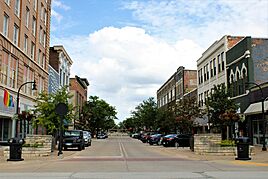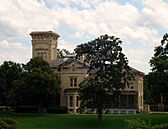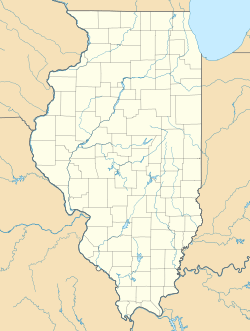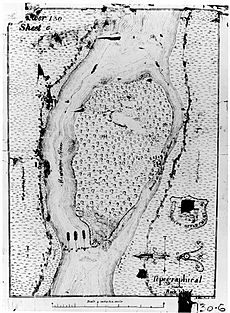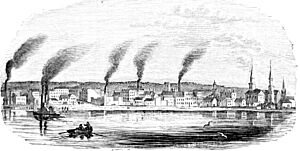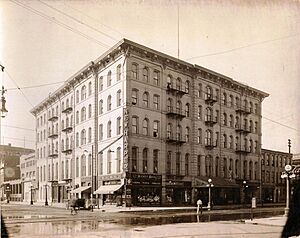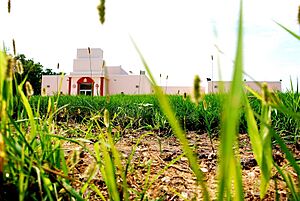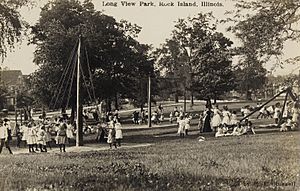Rock Island, Illinois facts for kids
Quick facts for kids
Rock Island, Illinois
|
|||||
|---|---|---|---|---|---|
|
|
|||||
|
|||||
| Motto(s):
Rock Solid, Rock Island
|
|||||

Location of Rock Island in Rock Island County, Illinois.
|
|||||
| Country | United States | ||||
| State | Illinois | ||||
| County | Rock Island | ||||
| Incorporated | 1841 | ||||
| Area | |||||
| • City | 17.07 sq mi (44.22 km2) | ||||
| • Land | 16.87 sq mi (43.70 km2) | ||||
| • Water | 0.20 sq mi (0.53 km2) | ||||
| Population
(2020)
|
|||||
| • City | 37,108 | ||||
| • Density | 2,199.51/sq mi (849.23/km2) | ||||
| • Metro | 384,324 (US: 147th) | ||||
| • CSA | 474,019 (US: 90th) | ||||
| Time zone | UTC−6 (CST) | ||||
| • Summer (DST) | UTC−5 (CDT) | ||||
| ZIP Codes |
61201, 61204, 61264, 61299
|
||||
| Area code(s) | 309 | ||||
| FIPS code | 17-65078 | ||||
| Interstate Spurs | I-280 | ||||
| Website | http://www.rigov.org/ http://www.rocksolidrockisland.com/ | ||||
Rock Island is a city in Illinois, located in Rock Island County. In 2020, about 37,108 people lived here. The city sits where the Rock River meets the mighty Mississippi River.
Rock Island is one of the five Quad Cities. These cities include Moline and East Moline in Illinois, and Davenport and Bettendorf in Iowa. Together, the Quad Cities area had over 384,000 people in 2020.
The city is home to Rock Island Arsenal. This is the largest government-owned factory in the U.S. that makes weapons for the U.S. Army. It employs about 6,000 people. The island that gave the city its name is now called Arsenal Island.
Contents
- Rock Island's Past
- Rock Island's Location
- Weather in Rock Island
- People of Rock Island
- Rock Island's Economy
- Rock Island County Courthouse
- Learning in Rock Island
- Places to Visit
- Arts and Culture
- Sports in Rock Island
- Media in Rock Island
- Getting Around Rock Island
- Famous People from Rock Island
- See also
Rock Island's Past
Rock Island has a long and interesting history. It was first a great spot for people to settle. Later, it became important for riverboats, bridges, and trains.
Early Settlements
The first part of what is now Rock Island was called Farnhamsburg. This name came from the first two homes built there in 1826. Colonel George Davenport and Russell Farnham built these homes. They were business partners who traded with the local Native Americans.
The city was officially planned on July 10, 1835, and was first named Stephenson. It was renamed Rock Island in March 1841.
The southern part of Rock Island was known as Searstown. It was named after David B. Sears. He built the Sears Power Dam on the Rock River. Searstown became part of Rock Island in 1915.
Trains and Growth
The Chicago, Rock Island & Pacific Railroad (RI) started here in 1851. People often called it the Rock Island Line. Over the next 100 years, this railroad grew to serve 14 states. However, it went out of business in 1980.
In the late 1800s, two fancy hotels were built in town. These were the Harper House (opened in 1871) and the Rock Island House. The Rock Island Arsenal has been making military equipment for the U.S. Army since the 1880s.
The Rock Island Southern Railway was an electric train line. It ran from Rock Island to Monmouth, Illinois, and then to Galesburg, Illinois. It was built between 1906 and 1910. This line closed in 1952.
Amazing Bridges
Rock Island has many bridges because of its location. It even had the first railroad bridge across the Mississippi River! It also has a unique two-track railroad bridge and the world's largest roller dam.
The first railroad bridge across the Mississippi River was built in 1856. It connected Arsenal Island and Davenport. Many steamboat captains did not like this bridge. They felt it made it hard for their boats to pass. This led to a big argument between St. Louis (with its steamboats) and Chicago (with its railroads).
Just two weeks after the bridge opened, a steamboat called the Effie Afton hit the bridge. It caught fire and damaged the bridge. The steamboat owner sued the bridge company. Abraham Lincoln was one of the lawyers who defended the railroad in court in 1857. The case went all the way to the U.S. Supreme Court. In 1862, the Supreme Court decided in favor of the railroad.
The original bridge is no longer there. A stronger bridge replaced it in 1866. You can find a monument on Arsenal Island marking where the Illinois side of the first bridge was.
The Lock and Dam No. 15 and the Government Bridge are near where the first bridge stood. The Government Bridge, finished in 1896, is special. It has two sets of train tracks above the car lanes. Only two bridges in the world have this feature!
Three other bridges cross the river between Rock Island and Davenport. The Crescent Rail Bridge is only for trains and was finished in 1899. The Centennial Bridge was built in 1940 for cars. The newest bridge is the Interstate 280 bridge, finished in 1973.
Lock and Dam No. 15 was completed in 1934. It was a project during the Great Depression. It is the largest roller dam in the world. This dam helps boats travel on the river. It is not for flood control. During floods, the rollers are lifted to let the water flow freely.
On the south side of the city, near the Black Hawk State Historic Site, are bridges over the Rock River to Milan, Illinois. These bridges also cross the old Hennepin Canal and Sears Dam. In 2007, a new bridge was finished. It makes it faster to get to Milan, the airport, and places south on U.S. Route 67.
Rock Island's Location
Rock Island is located at 41°29′21″N 90°34′23″W / 41.48917°N 90.57306°W.
In 2010, Rock Island covered about 17.87 square miles (46.29 square kilometers). Most of this area, about 16.85 square miles (43.64 square kilometers), is land. The rest, about 1.02 square miles (2.64 square kilometers), is water.
Weather in Rock Island
|
||||||||||||||||||||||||||||||||||||||||||||||||||||||||||||||||||||||||||||||||||||||||||||||||
People of Rock Island
| Historical population | |||
|---|---|---|---|
| Census | Pop. | %± | |
| 1850 | 1,711 | — | |
| 1860 | 5,130 | 199.8% | |
| 1870 | 7,890 | 53.8% | |
| 1880 | 11,659 | 47.8% | |
| 1890 | 13,634 | 16.9% | |
| 1900 | 19,493 | 43.0% | |
| 1910 | 24,335 | 24.8% | |
| 1920 | 35,177 | 44.6% | |
| 1930 | 37,953 | 7.9% | |
| 1940 | 42,775 | 12.7% | |
| 1950 | 48,710 | 13.9% | |
| 1960 | 51,863 | 6.5% | |
| 1970 | 50,166 | −3.3% | |
| 1980 | 46,821 | −6.7% | |
| 1990 | 40,552 | −13.4% | |
| 2000 | 39,684 | −2.1% | |
| 2010 | 39,018 | −1.7% | |
| 2020 | 37,108 | −4.9% | |
| 2022 (est.) | 36,256 | −7.1% | |
| U.S. Decennial Census 2010 2020 |
|||
In 2020, Rock Island had a population of 37,108 people. The city has a diverse population. About 59% of residents were White, and about 19% were Black or African American. Around 11.5% of the population was Hispanic or Latino.
Rock Island's Economy
Rock Island has several large employers that provide many jobs.
Top Employers
Here are some of the biggest employers in Rock Island:
| # | Employer | # of Employees |
|---|---|---|
| 1 | Rock Island Arsenal | 6,301 |
| 2 | Trinity Rock Island (a hospital) | 1,848 |
| 3 | Rock Island–Milan School District 41 | 1,292 |
| 4 | Rock Island County | 733 |
| 5 | Jumer's Casino & Hotel | 550 |
| 6 | Augustana College | 550 |
| 7 | Pfg Tpc Roma Foods | 530 |
| 8 | City of Rock Island | 436 |
| 9 | Modern Woodmen of America | 435 |
| 10 | Honeywell Safety Products | 400 |
Rock Island County Courthouse
A new courthouse for Rock Island County was built from 2017 to 2018. The old courthouse was taken down in April 2023, after some local people tried to save it.
Learning in Rock Island
Most of Rock Island is served by the Rock Island–Milan School District 41. This district has one high school, two junior high schools, and nine elementary schools. There are also private schools like Jordan Catholic Elementary School and Alleman Catholic High School.
High Schools
- Alleman High School
- Rock Island High School
- Rockridge High School (in Taylor Ridge, Illinois)
Colleges
- Augustana College
- Bible Missionary Institute
Places to Visit
Rock Island has many interesting places to see:
- Augustana College (Illinois)
- Bally's Quad Cities Casino & Hotel
- Black Hawk State Historic Site
- Broadway Historic District
- Chippiannock Cemetery
- Hauberg Civic Center
- Longview Park Conservatory and Gardens
- Quad City Botanical Center
- Rock Island Public Library
- Rock Island Arsenal is a National Historic Landmark
The Quad City Hindu Temple is in Rock Island, Illinois. It is a Hindu temple mainly for the god Venkateswara. The temple opened in 2007. Before it was built, Hindu worshippers had to travel far to attend festivals.
Arts and Culture
Rock Island is home to several cultural groups:
- Ballet Quad Cities
- Genesius Guild
- The Quad City Symphony Orchestra performs some of its concerts at Augustana College.
- Quad City Arts
Sports in Rock Island
Rock Island has a rich sports history.
The very first football game that led to the National Football League was played in Rock Island in September 1920. The team was the Rock Island Independents (1907–1926). They were one of the first NFL teams.
The Rock Island Islanders were a minor league baseball team. They played for 37 seasons between 1901 and 1948.
The Rock Island Legion Post 200 baseball team won its fourth state championship in 2011.
Kart racers come to Rock Island every year for the exciting Rock Island Grand Prix. This race happens on Labor Day weekend. Racers from all over the U.S. and the world compete. The race has been held every year since 1994, except for 1997.
Rock Island High School has won state championships in many sports. These include basketball, track, softball, and wrestling. Their football and basketball teams are often very strong. The Rock Island Public Schools Stadium has a special artificial field and can seat over 15,000 people.
Media in Rock Island
Rock Island is where television station WHBF-TV is located. For many years, WHBF was one of only two TV stations in the Quad Cities area.
National Public Radio station WVIK is also in Rock Island. It is on the campus of Augustana College. Another station, WGVV-LP, is also licensed to Rock Island.
Rock Island is the home base for NOAA Weather Radio WXJ-73. This is the weather radio station for the Quad Cities area. It is run by the National Weather Service in Davenport.
Getting Around Rock Island
Quad Cities MetroLINK provides bus service in Rock Island. Buses connect Rock Island to other places in the Quad Cities. The District Station in downtown Rock Island is a main bus hub.
Famous People from Rock Island
Many notable people have connections to Rock Island:
- David Ackles, singer-songwriter
- Eddie Albert, famous actor from Green Acres
- Black Hawk, a leader of the Sauk American Indian tribe
- John Buford, a Civil War general
- George Davenport, an early trader and soldier
- Steve Decker, a baseball catcher
- Pony Diehl, a Wild West outlaw
- Booker Edgerson, a football player for the Buffalo Bills
- Lane Evans, a former U.S. Congressman
- Russell Farnham, one of the first settlers
- Therese Fowler, author
- June Haver, actress
- Chase Hilgenbrinck, a professional soccer player
- Roger Imhof, actor
- Jesse Johnson, musician
- Madison Keys, professional tennis player
- Kari Lake, news reporter and political candidate
- Helen Mack, actress
- Elisabeth Maurus (aka Lissie), folk-rock singer
- Tim Moore, actor, one of the first Black TV stars
- Don Nelson, famous NBA coach
- Gary Payton, an astronaut
- Chasson Randle, basketball player
- Bobby Schilling, a U.S. Congressman
- Dred Scott, an American slave who sued for his freedom
- Henry Strasak, FBI and CIA officer
- Jonathan Tweet, a game designer
- Henry Cantwell Wallace, U.S. Secretary of Agriculture
- Friedrich Weyerhäuser, a lumber leader
See also
 In Spanish: Rock Island (Illinois) para niños
In Spanish: Rock Island (Illinois) para niños


